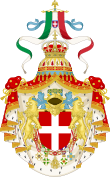National Council Consulta Nazionale | |
|---|---|
 | |
| History | |
| Preceded by | Parliament of the Kingdom of Italy |
| Succeeded by | Constituent Assembly of Italy |
| Leadership | |
President of the Council | |
| Structure | |
| Seats | 304 |
 | |
Political groups | |
| Meeting place | |
| Palazzo Montecitorio, Rome | |
The National Council (Consulta Nazionale) was an unelected provisional legislative assembly set up in the Kingdom of Italy after the end of World War II. It fulfilled the roles of parliament until regular elections could be held. It first sat on 25 September 1945 and was dissolved after the national elections on 2 June 1946, which formed the first Constituent Assembly of Italy.
